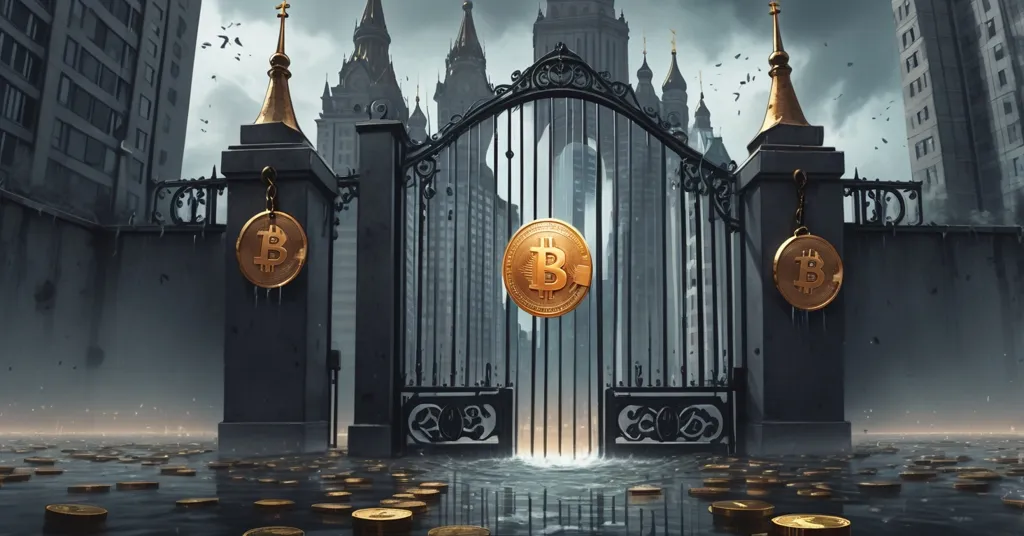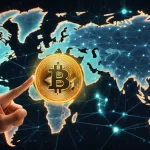Russia Raises Digital Asset Limits, Tightens Bitcoin Restrictions Amid Sanctions

Russia Boosts Digital Asset Investment Limits Amid Sanctions, Tightens Bitcoin Control
Russia’s Central Bank (CBR) has dropped a significant update, proposing to raise the annual investment limit for non-qualified investors in Digital Financial Assets (DFAs) from 600,000 rubles (roughly $7,600) to 1 million rubles (over $12,600). Alongside this, legal entities are getting a free pass to invest without restrictions, a move clearly aimed at fueling business activity as Western sanctions continue to squeeze the nation’s financial arteries. Yet, don’t pop the champagne just yet—decentralized cryptocurrencies like Bitcoin remain behind a velvet rope for the ultra-wealthy elite.
- Limit Hike for the Masses: Non-qualified investors could soon invest up to 1 million rubles yearly in DFAs.
- Business Bonanza: Legal entities face no caps on DFA investments, a sanctions-driven push for economic resilience.
- Bitcoin Lockout: Decentralized crypto like BTC is still reserved for the ultra-rich, with sky-high barriers.
Decoding Digital Financial Assets: What Are DFAs?
Before we dig deeper, let’s break down what Digital Financial Assets (DFAs) actually are, especially for those new to the crypto game. In Russia, DFAs are essentially digital versions of traditional investments—think stocks, bonds, commodities like oil or gold, or even foreign currencies—recorded on secure, government-approved digital ledgers called private blockchains. Unlike Bitcoin’s open, anyone-can-join network, these blockchains are tightly controlled by platforms authorized by the CBR. DFAs also include “digital rights,” which can mean monetary claims or investor privileges, and in some cases, certain stablecoins—digital currencies designed to keep a steady value by being tied to real-world assets like fiat money. For a deeper dive into the legal framework, check out this overview of Russia’s DFA regulations.
The CBR’s proposal to bump the investment cap from 600,000 to 1 million rubles annually for non-qualified investors—basically, regular folks without millionaire portfolios—signals a slight opening of the digital finance door. This means the average Russian can put a bit more cash into these tokenized assets without needing to jump through the hoops of becoming a “qualified” investor, a status that demands serious financial muscle. To put it in perspective, 1 million rubles might buy you a decent chunk of a tokenized bond or a slice of a digital commodity index, though exact costs depend on the asset and platform—details the CBR remains annoyingly vague about. More specifics on this investment ceiling increase can shed light on the changes.
Businesses Get a Green Light: A Sanctions Workaround?
Now, if you thought this was just about empowering the little guy, think again. The real eyebrow-raiser here is the complete removal of investment limits for legal entities, whether they’re qualified or not. This isn’t a minor tweak; it’s a brazen attempt to get businesses—big and small—using DFAs as alternative financial tools. With Western sanctions, including exclusions from global systems like SWIFT, hammering Russia’s economy since the Ukraine conflict, tokenized assets on controlled blockchains could be a lifeline for trade and investment. Need to settle a cross-border deal without touching Western banks? A DFA might just do the trick, assuming the CBR’s iron grip doesn’t choke the process. Learn more about the details of this limit increase for investors.
This move dovetails with Russia’s broader strategy to dodge financial isolation. Some Russian firms are already testing crypto-based systems for international trade under government approval, especially after high-profile incidents like Tether freezing assets tied to sanctioned exchanges. It’s pragmatic, sure, but let’s not kid ourselves—it’s also a stark reminder that state control, not freedom, is the priority here. For a broader perspective on how sanctions influence these policies, this discussion on sanctions’ impact offers some insight.
Bitcoin’s Iron Curtain: Only for the Oligarchs
While DFAs are getting a cautious nod, decentralized cryptocurrencies like Bitcoin (BTC) remain a no-go zone for most Russians. Want to hodl some BTC in Moscow? Better have a yacht-sized wallet. Access is strictly limited to “highly qualified” investors, defined as those with an annual income over 50 million rubles (about $633,000) and investment portfolios exceeding 100 million rubles (around $1.27 million). For the rest of us peasants, Bitcoin’s promise of financial sovereignty is a distant mirage, locked behind Russia’s regulatory Iron Curtain. See the official stance with these Bitcoin access restrictions from the CBR.
The reasoning? The CBR cites fears of capital flight—money fleeing the country—and illicit activities like money laundering. Fair enough, those are real risks. But let’s be brutally honest: this is also about keeping a stranglehold on the ruble’s value and ensuring capital doesn’t slip into uncontrollable, borderless networks like Bitcoin’s. The irony stinks—Russia’s flirting with blockchain innovation while terrified of the very decentralization that makes crypto revolutionary. It’s like wanting the shiny new tech toy but smashing its core feature with a hammer. Community reactions to these policies can be found in this thread on Bitcoin restrictions under sanctions.
Stablecoin Crackdown: USDT and USDC Get the Boot
Adding another layer to this regulatory maze, Russia’s new rules on Foreign Digital Rights (FDRs) are slamming the door on popular stablecoins like Tether (USDT) and USDC. FDRs cover digital assets linked to foreign securities or jurisdictions, and the CBR is now banning those tied to “unfriendly nations”—read: the West—or assets that issuers can freeze. The official line is “investor protection from elevated risks,” but let’s call it what it is: a middle finger to Western financial tools that can be weaponized through sanctions.
A prime example hit earlier this year when Tether blocked assets worth 2.5 billion rubles (roughly $30 million) linked to Garantex, a Russian crypto exchange accused by the U.S. of money laundering and sanctions evasion. That kind of rug-pull hurts, and Russia’s not keen on letting foreign entities hold that kind of power over its markets again. The result? Stablecoins like USDT, often used for stable cross-border transactions, are effectively barred, pushing Russians away from dollar-pegged assets and toward domestic alternatives. For more on this, explore the stablecoin proposal and Tether sanctions impact.
A Ruble-Pegged Stablecoin: Innovation or Surveillance Trap?
Speaking of alternatives, Russia’s finance ministry isn’t just sitting on its hands. Following the Tether debacle, they’re exploring a homegrown stablecoin, likely pegged to the ruble or another “friendly” nation’s currency rather than the U.S. dollar. Osman Kabaloev, Deputy Head of the Financial Policy Department, has been vocal about this, arguing it’s a way to sidestep foreign regulatory overreach and sanctions.
Russia needs a stablecoin to minimize dependence on foreign authorities and external sanctions risks.
On paper, this sounds like a clever move. A ruble-backed stablecoin could offer businesses a stable digital currency for trade without the specter of a Tether-style freeze. It fits Russia’s de-dollarization obsession, seen in past ideas like a gold-backed digital currency for deals with allies like Iran. But hold your applause—a state-backed coin screams centralization. If the CBR controls the issuance and tracks every transaction, this isn’t financial freedom; it’s Big Brother with a crypto wallet. Compared to Bitcoin’s pseudonymous, decentralized ethos, a ruble-coin could be a surveillance nightmare, giving the state even more power to monitor and meddle. Check out this analysis of stablecoin development versus Bitcoin restrictions for a deeper comparison.
The Other Side: Should Russia Embrace Bitcoin?
Let’s play devil’s advocate for a moment. What if Russia loosened its chokehold on Bitcoin and decentralized crypto? Sure, capital flight is a concern—people could dump rubles for BTC and send wealth abroad in a heartbeat. And yes, illicit use is a problem globally, not just in Russia. But Bitcoin could also be an economic lifeline, especially under sanctions. It’s a borderless currency that doesn’t care about SWIFT bans or Western politics. If everyday Russians and businesses could tap into it, they might find new ways to trade, invest, and thrive outside the traditional financial cage.
From a Bitcoin maximalist lens—and I’ll admit a bias here—decentralization is the ultimate middle finger to oppressive systems, whether they’re Western sanctions or domestic overreach. Russia’s current path, shackling BTC while pushing controlled DFAs, risks missing the forest for the trees. Innovation doesn’t come from control; it comes from chaos and freedom. That said, the state’s perspective isn’t baseless. Unchecked crypto could destabilize an already shaky ruble, and not every user is a noble freedom fighter—some are just crooks. So, is this really about protection, or a convenient excuse to keep capital leashed? Chew on that.
Global Parallels: Russia in the CBDC Race
Russia’s digital asset dance isn’t happening in a silo. Across the globe, nations under economic pressure or geopolitical scrutiny are racing to build state-backed digital currencies. China’s digital yuan is already in play, aiming to undercut foreign stablecoin dominance and boost state oversight. India’s pushing a central bank digital currency (CBDC) too, with similar goals. Even sanctioned countries like Venezuela have dabbled with crypto—think the Petro, a state-issued coin backed by oil, or Iran’s embrace of Bitcoin mining to dodge U.S. penalties.
Russia’s approach stands out for its defensive edge. Unlike Venezuela’s half-hearted crypto experiments, which flopped due to mismanagement, Russia’s DFA push and stablecoin plans are paired with ruthless control over decentralized alternatives. It’s less about embracing blockchain’s full potential and more about weaponizing parts of it to survive sanctions. This raises a bigger question for the crypto world: if more nations follow Russia’s lead—adopting blockchain but rejecting decentralization—are we just trading one set of overlords for another?
Real-World Impact: What Does 1 Million Rubles Buy?
For the average Russian, what does this DFA limit hike actually mean? A cap of 1 million rubles sounds nice, but without clear data on tokenized asset prices—thanks, CBR, for the transparency—it’s hard to pin down. Rough estimates suggest it could cover a modest stake in digital bonds, a sliver of a commodity like oil or gold, or a bundle of index-based instruments. It’s not chump change, but it’s not exactly “quit your day job” money either. For businesses, though, the sky’s the limit. A mid-sized firm could theoretically dump millions into DFAs for trade or hedging, assuming the state-approved platforms don’t bog them down with red tape.
Public consultation on these changes runs until June 15, 2025, with the rules set to kick in just 10 days after the final circular drops. Meanwhile, some FDR restrictions are already phasing in, with key bans effective as early as May 26, 2025. It’s a staggered rollout, showing Russia’s trying to balance a quick sanctions response with some semblance of public input. Whether that input matters is another story.
Key Takeaways and Questions on Russia’s Crypto Moves
- What’s driving Russia’s increase in Digital Financial Asset (DFA) investment limits?
The Central Bank is raising the cap for non-qualified investors to 1 million rubles annually to make tokenized investments more accessible, responding to market demand while navigating Western sanctions that limit traditional finance options. - How do Bitcoin restrictions in Russia affect decentralization?
Bitcoin access is limited to “highly qualified” investors with massive wealth, blocking most Russians from decentralization’s benefits and prioritizing state control over fears of capital flight and illicit activity. - Why is Russia banning stablecoins like Tether (USDT) and USDC?
New Foreign Digital Rights rules target assets from “unfriendly nations” or those freezeable by issuers, as seen with Tether’s $30 million block on a sanctioned Russian exchange, aiming to reduce reliance on Western financial tools. - Is a Russian stablecoin a viable alternative to decentralized crypto?
A proposed ruble-pegged stablecoin could stabilize trade under sanctions, but its centralized nature risks becoming a surveillance tool, lacking the privacy and freedom inherent in Bitcoin and other decentralized currencies. - How do sanctions shape Russia’s blockchain and cryptocurrency policies?
Western sanctions, including SWIFT bans, push Russia to adopt controlled DFAs for trade and business while rejecting Bitcoin’s uncontrolled network to prevent capital outflows, striking a tense balance between innovation and restriction.
Russia’s digital asset gamble might accelerate blockchain adoption in a sanctioned economy, but at what cost to freedom? If control keeps trumping decentralization, we’re just swapping one set of chains for another. This chess game is far from over, and the stakes for crypto’s future—globally and locally—couldn’t be higher. Stay sharp, because this is one battle worth watching.



